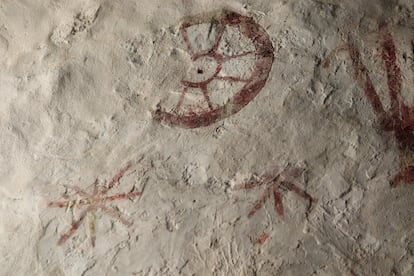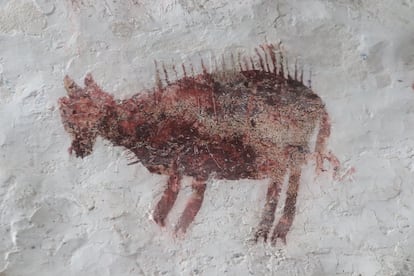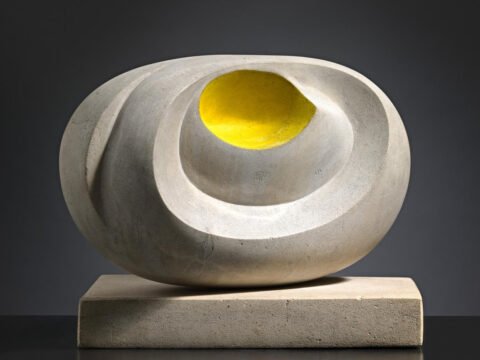On one of the walls of the church in Arbulo – a village in the northern Spanish province of Álava with barely 100 inhabitants – schematic figures including crosses and eight-spoked discs are painted alongside various animals, such as wild boars, various birds and a peacock. They follow no logical order; drawn in a slightly dull red, dating back to the 12th century, they seem to “float” on the wall.
Art historian Gorka López de Munain, a native of the area, has long been familiar with the church. But it’s only now, after a recent restoration and the discovery of these drawings on the oldest wall of the building, that he’s pondering their possible meaning.
So far, as he conducts a thorough investigation, the professor – who teaches at the University of the Basque Country – has found some answers. For instance, he has determined that this isn’t an isolated case, but rather “a cultural phenomenon” that’s present in other houses of worship that were built during the medieval era.
However, many questions still remain. What was the point of these drawings in a supposedly Christian church? Were they created behind the backs of the dominant religion? And, above all, what are they trying to tell us?
Until now, little information was available about this style of painting, with its reddish color and schematic forms. “We hadn’t studied it because it was outside the art-historical canon,” López de Munain explains. That is, the tradition was outside the kind of Western art that we usually associate with the catalog of the 12th and 13th centuries: the frontal images and varied colors – so characteristic of the Romanesque style – to the more expressive Gothic. During these years, in Europe, Christianity was always the dominant theme.
However, these other works “are very interesting, [as they help us] understand the society of the time,” López de Munain argues. And this type of drawing isn’t exclusive to the Church of San Martín de Arbulo. It can also be seen in other buildings in the province of Álava, and there are other similar examples beyond the Basque Country. Research conducted by art historians, as well as recent restorations, have led to new discoveries. Today, more and more clues are emerging about a still-unsolved mystery.

Anyone who looks at the drawings in Arbulo will feel as if they’ve seen them somewhere else before. In fact, they’re part of a visual culture that “connects with a long-standing repertoire that dates back to Antiquity and [remained] alive in the Middle Ages.” The drawings of sun disks are part of this tradition: these were “present in ancient cultures – even pre-Roman ones – and later spread to the Roman world through [engravings on] tombstones,” López de Munain clarifies. He studies this type of artistic expression over the broadest possible time frame. The motifs are the same, but their meaning is different. The only thing that has remained the same is the appearance, the form of the drawings. “The meanings have probably been modified, even changing [in a completely radical way]; today, many of these images have been reinterpreted, for example, within Basque culture and imagery, where they blend with a 21st-century perspective,” the art historian explains.
So, beyond their artistic craftsmanship, their ingenuity, their simplicity and their color, why do illustrations like those found in the Church of San Martín de Arbulo attract so much attention? “When you enter a 12th-century church, what you expect is Christian iconography,” the professor notes. “And that’s the key point: this isn’t that kind of iconography, which makes it harder to understand.”
What most caught López de Munain’s attention were the animals that resemble boars or pigs. “The figure of a peacock can be connected to other traditional models… but a boar in the middle of nowhere and four-legged creatures with claws seem to represent the environment, rather than a familiar trend or repertoire,” he analyzes. Regarding the eight-spoked discs that appear on the medieval wall of the church – one of them larger and featuring two concentric spheres, resembling a wagon wheel – he notes that he realized “that they were present in other objects that we haven’t paid much attention to, such as [upright stone slabs and columns].” These elements are also very present in another of the Romans’ great artistic contributions: mosaics.

With all this data on the table, it was time to propose a hypothesis about the illustrations. “These were churches with very little constructive ambition – promoted by the local minor nobility – and this was their imagery,” López de Munain explains. In other words, temples like the one in Arbulo were “private churches,” whose owners projected what they saw in their surroundings. But why were there elements of Roman culture?
“They were aware that there were other buildings from Antiquity (Roman, in this case) that were associated with something prestigious,” the historian suggests. If they used symbols from an older culture with a grand reputation, their lineage would somehow date back to that age of splendor. And they also did so as an expression of “a popular perspective,” the researcher adds, referring to a detail that describes “social classes about which so far we know very little.”
The detailed investigation has allowed López de Munain to get closer to the true meaning behind the drawings, which can be summed up in a simple idea: “Find a prestigious image and appropriate it.” But there was still room for further investigation. The clue lay in certain animals that are depicted in the drawings. “Some of the images have a clear funereal tradition, such as the peacocks, or the birds confronted with a bunch of grapes that appear on Roman tombstones,” he describes. Therefore, “these types of churches were used for burials, as has been [revealed] through archeology,” the professor affirms. “They were private temples where the owners did more or less what they wanted, outside the interference of the episcopates.”
This reasoning allows us to ask a final question: do these types of images reflect particular beliefs that were hidden from Christianity, the dominant religion? “It’s a very difficult question to answer; certainly, behind the [bishop’s] back, yes,” López de Munain reflects.

Perhaps what these drawings are trying to tell us is that temples like the one in Arbulo weren’t exactly Christian. “The crosses we see are the only [things] that tells us we’re in a Christian church. [As] for the rest [of the artwork], not a single image hints at it,” the researcher responds.
The same is true of the other medieval buildings – which are so characteristic of the province of Álava – that display those red, schematic paintings. But then, if they weren’t Christian, what were they?
The aim of the research isn’t to offer all the answers (an impossible mission), but rather to “take a first step” and pave the way for further investigations to better understand an artform that – by straying from the beaten path – has been relegated to oblivion.
Sign up for our weekly newsletter to get more English-language news coverage from EL PAÍS USA Edition




